


The 1st Battalion, 10th Engineers -- 11th Battalion, 20th Engineers

Note: Most of the text of this article comes from "TWENTIETH ENGINEERS -- FRANCE -- 1917-1918-1919"
The Tenth Engineer Regiment (Forestry) was one of the pioneer units in the new war Army of the United States. The formation of this unique body of engineers was commenced in May, 1917 , the organization and recruiting being very largely accomplished by Forest Service, from which also came an important percentage of the personnel. Every soldier in the regiment was a volunteer.
The two battalions of the 10th Engineers were formed
by the 1st of August at American University, at which camp they were among the
newcomers, and from then until September 8th was spent in military drill and equipping.
Sunday, the 9th of September, the regiment marched to Roslyn where it entrained for Jersey
City, arriving there the morning of the 10th.
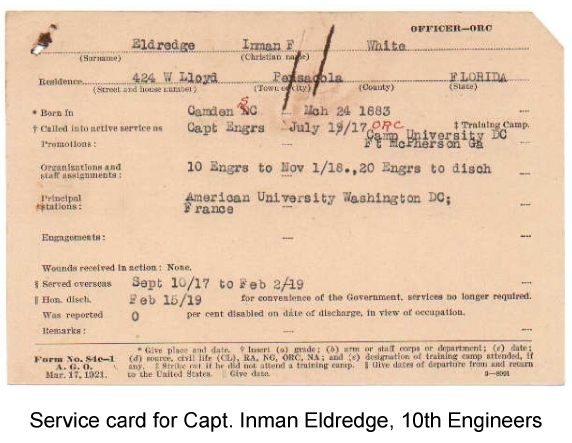
Ferried across the Hudson to the Cunard pier on the New York side of the Hudson and boarding the RMS Carpathia, the first forest troops left for France on the evening of the same day. Also on board were the Second Engineers, fresh from the Mexican Border. The 10th Engineers were among the first 10,000 troops sent to France.
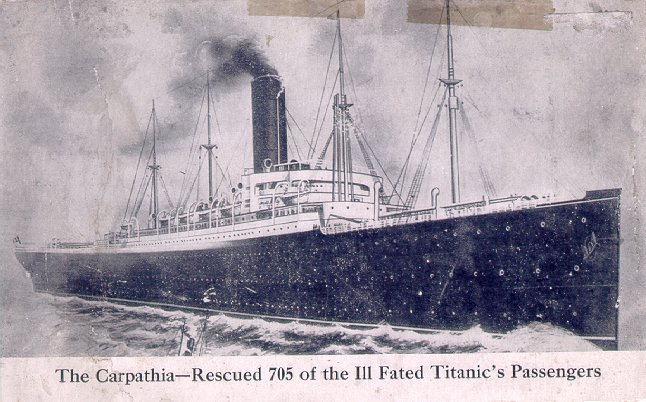
The Carpathia had quite the history of her own, in addition to transporting the 10th Engineers to France.
She was the first to arrive to help rescue survivors of the Titanic disaster.
Later in the war, on 17 July 1918, she was torpedoed by a U-Boat and sank off the coast of Ireland.
Two days more and the Carpathia reached Halifax, Nova Scotia, where the formation of a convoy was in progress. On the 21st the convoy of thirteen ships, some with Australian, New Zealand, and Canadian troops aboard, headed for England in three columns. Carpathia enjoyed a voyage unmolested by enemy subs and upon arrival at Glasgow, on the Clyde, the American troops were received by the Scotch with enthusiasm. These were the first Yanks to land in the historic city and the excitement was intense as the soldiers of the new Ally disembarked.
A few days were spent in camp at Southampton, and on the night of October 6th the regiment crossed the Channel on La Marguerite, arriving in Havre at 5 o'clock in the morning. A short period was spent in a British 'rest camp' at Havre and at 10 P.M. a thirty six hour boxcar ride began which ran past the palace of Versailles and set the foresters down almost in the center of France.
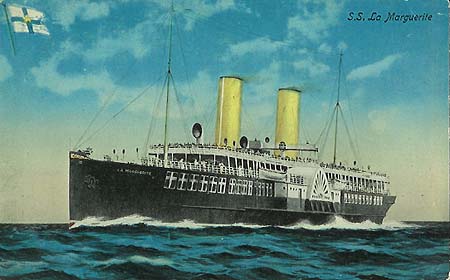
Click on the postcard of the La Marguerite for more information on this workhorse cross-Channel steamer
Two weeks were spent in the mud there while the arrival of motor and sawmill equipment from the Carpathia was awaited, during which time the inevitable drill was indulged in extensively. Only a part of the regiment's equipment had arrived on the Carpathia.
The immediate needs of the vigorous young A. E. F. were such as to require the forest troops to be split into several parts for service in widely separated regions of France. Two battalion headquarters were established by the 1st of November, one at Pontenx-les-Forges in the Landes pines and the other in the fir region, at Levier (Doubs). The logging equipment was at that time very incomplete and some of the detachments were reduced to the expedient of hauling logs by manpower. The first mill to begin operations was a small French affair that bit into the first log sawed by American forest troops on November 25th, 1917, at Levier. Two days later the Mortumier operation, near Gien (Loiret) started the first American mill. During the month of December a large part of the work was necessarily confined to the production of round products. Two French and one American mills were under way by the first of the month and before the end of December two American and four French mills were at work. The December production, all to the credit of the Tenth Engineers, was as follows: Lumber, 321,000 F. B. M. [board feet]; Piling, 205 pieces; Ties, 12,031 pieces; Poles, 20,025 pieces; Logs, 33,864 pieces; Cord wood, 4,164 steres (cubic meters); Fagots [bundles of fireweed], 1,500 steres [cubic meters].
The early distribution of the regiment may be briefly summarized as follows, together with the first stations that each detachment held and the designations given the companies after the reorganization, of the forest troops consolidated them all under the Twentieth Engineers. The old designations will be used as a rule.
Regimental Headquarters - Tours, merged with Headquarters of Twentieth Engineers
First Battalion Hq. - Pontenx, Eleventh Bn.
Company A - Thirty second Co. - 1/2 Pontenx District; 1/2 Brittany.
Company B - Thirty third Co. - Pontenx District.
Company C - Thirty fourth Co. - Pontenx District.
Second Battalion Hq. - Levier, later Besancon, in the Doubs, Twelfth Bn.,
Company D - Thirty fifth Co. - Arc-sous-Montenot (Doubs).
Company E - Thirty sixth Co. - 1/2 Vaney (Cote d Or); 1/2 at Gien (Loiret).
Company F - Thirty seventh Co. - Levier (Doubs).
One half of Co. A, known also as the Third Detachment, Tenth Engineers, and as "The Kelly Outfit," consisted of 130 men, later reinforced by men from the Third and Fourth Battalions, Twentieth Engineers. The Detachment built camp at Bellevue, near Pontenx, (known as "Kellyville" in recognition of the energetic commanding officer), where it was joined by the reinforcements of the Twentieth Engineers from Blois early in February. The first mill was a small and inefficient piece of machinery, but it sufficed to turn out lumber for the construction of the camp buildings and the new 20-M American mill which was completed in the latter part of March, and started on two 10 hour shifts. At about the time of the completion mill, Lt. Kelly was killed in a motorcycle accident while hastening for spare parts.
The mill averaged from 27,000 feet of inch boards to 45,000 feet of other lumber each shift. The head sawyer (Johnson from Mississippi) was a buck private until only a few months before the outfit went home. At first teams were used to haul logs into the mill, but a steam engine was soon substituted. A detachment of Co. D, Forty-first Engineers, was added to the strength of the operation in May. With the strength of a full company the operation kept six or eight crews in the woods and averaged 80 to 100 logs a day each.
In September, the Detachment for a new station at Sore, a small place near the town of Labouheyre, an important junction on the Midi line from Bordeaux to Madrid, Spain, being relieved at Pontenx by the balance of the 41st Co. The Sore operations were carried on until the Detachment joined the rest of the First Battalion on its homeward journey. Several of the companies of the Regiment were reinforced by transfers from the Twentieth, and were soon up to the new war strength. The 10th Engineers strength, after reinforcement was 1,485 men and 34 officers.
Company B was assigned to what was perhaps unusual operation of any attempted by the forest troops. The 20-M American mill was built on the east shore of Lake Aureilhan, opposite the shooting lodge of " 'is Gryce," the Duke of Westminster, and five miles west of the village of Pontenx. Part of the company operated the mill; the rest of the men were stationed in what was known as "the river camp,"" four miles northwest. A narrow gauge railroad took the logs to the river on which they were driven to the lake. At the mouth of the river booms were built and the logs were rafted across to the mill by means of a 24 foot French motorboat. After 13 months of operation the Armistice came along and on Armistice day essential parts of the mill were thrown into the lake, stopping the works. Shortly after the end of 1918, the outfit left for home with the other Pontenx units of the Regiment, and other troops took over the Aureilhan mill.
Company C built camp and mill at La Broquette, a hamlet one mile east of St. Eulalie ("Ukelele") and three miles west of Pontenx. Three miles of narrow gauge were built to haul production to the main line at Pontenx. The mill, a 20-M American plant, was completed in February. Forty men and a shavetail from Company A of the 42nd Engineers arrived to reinforce the operation early in June.
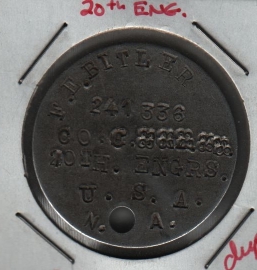
One of the aluminum "dog tags" belonging to F. E. Bitler, originally assigned to Company C, 1st Battalion, 10th Engineers. You can see the dogtag was later overstamped so the battalion designation no longer showed, and a 2 was superimposed over the 1 to change the designation from 10th to 20th Engineers. Also shown in the service number 241336 belonging to Bitler, plus the fact that he was in the "National Army," the part of the Army that was permanent and not just raised for the war.
A few of the red letter days at Pontenx are here given to recall some of the big events. April 16th Captain Guthrie left his command, to the sincere regret of these with whom he had served. May 6th brought Elsie Janis to cheer the homesick ones with the sight and sound of a real live American girl. During April and May drill was enjoyed after working hours, on Sundays, and Saturday afternoons. Decoration Day the First Battalion of the Tenth defeated the Fourth Battalion of the Twentieth in baseball, 2 to 1. June 14th brought new orders for no more weekend passes to Arcacahon, no overnight passes, and blouses were required to be worn when not working.
The appreciation of the men for several blessings, shared alike with all the grateful forest troops, should go on record. Chaplain Williams has a friend in every man of the forest forces. Friendly, fair, and forceful, he was found to be a man who knew what the men needed and how to get it. The Chaplain was in the habit of paying little visits of a few days' duration to each camp, living in camp and "observing all that took place within sight or hearing." He noted cases of mistreatment, of inadequate provision for the safety and comfort of the men and after he had left how things mysteriously improved. At one time a 1etter from a mere Corporal to the Senior Chaplain started an investigation of the officers' mess finances in one outfit that had most satisfactory results to the enlisted men. In one instance the negligence of a megacephalic battalion commander was working a hardship on the men in the woods and his personal example was unsatisfactory in the extreme. The Senior Chaplain noted all these things, and shortly after his departure a Colonel with a strange but determined countenance suddenly appeared in the woods. In a few days the battalion commander was on his way.
Another boon to the woods-bound lumberjack was the overseas woman. The men were appreciated, especially a certain jazz band and the First Army Quartet. But the real thing was the feminine element in the traveling troupes of entertainers and in the canteens of the leave areas. The Mademoiselle Cappelles and the Elsie Janises and the sweet, sisterly Y-girls were 100 proof in the eyes of Pvt. P. V. Stock, Engineer (Forestry).
AFTER THE ARMISTICE
"We received the news yesterday that the Armistice had been signed and of course the French people here went just wild, the same as every other place in France. They burned the Kaiser in effigy in Pontenx and had a big lantern parade. The thing that makes me sore is that they did not allow the mills to shut down and give the men a chance to celebrate. One of our men stole the big nut off the saw mandrel, and we had to shut down until we found it." So reports The Hoboken Sheet.
In general, the experiences of each outfit after the Armistice and on the homeward voyage were quite similar in many respects. The following story of homegoing of the First Battalion, Tenth Engineers, may be taken as fairly typical of all.
NOVEMBER 11th, 1918 -- FEBRUARY 7th, 1919
The justly famous news of the signing of the well-known Armistice reached Pontenx-les-Forges about 2:30 P.M. and La Broquette Camp shortly afterwards. However, it stuck there, having no effect on the operation of the mill; and the woods crews knew nothing of it until they came in to supper. The order went out from District Headquarters that the mills were to run as usual that night. But at C Company somevery thoughtfully removed the nut from the head saw, thus enabling the night shift to celebrate. Pontenx was not able to put on a very large show, but despite the worthy efforts of a large number, it did not go dry. On the proverbial morning after, activities started up as usual although there were quite a few familiar faces missing. At nine o'clock came word from Bordeaux that a holiday was declared for 24 hours. A few hours later arrangements were made for the battalion to go to Mont de Marsan, the capital of the Landes, and most of the officers, the band, and some of the men went to assist the celebration there. A few adventurous spirits made Bordeaux. One of these, in his desire not to cause work for any M.P., left the bosom of his breeches impaled on a fence surround the Gare du Midi.
For several days work went on as if the war had just begun, but on November 17th began the Battle of the Black Forest. Thanksgiving was observed in quite a creditable manner. The missing members of C Company returned from the Black Forest for dinner. That night came to the news that the First Battalion was to be ready to leave December 15th. But work continued as usual. Soon after, the men who had been on detached service came drifting in from all over France, including a member of C Company who had started for the Front several months before but landed on a rock pile in northern France. A little drilling was done at the various camps to prepare for the triumphal parade down Fifth Avenue--or maybe Pennsylvania!
On December 19th came orders to be ready to leave on the 26th, and a few days later the expeditionary force of C Company returned from the Black Forest with many tales of woe. The 4x4x12's came to most of the fellows before Christmas, which was in strong contrast with the experience of a package the year before which was mailed November 1st and arrived in Pontenx May 25th. (No, it didn't have a service stripe!) Christmas was not enjoyed to the fullest extend due to the breathless expectation of everyone, although the Y did its best by presenting each man with a package. In the meantime the battalion was doing clean-up work mornings and drilling evenings.
THE HOMEWARD TREK
On December 30th the homegoing began. The trip did not begin as a luxurious and speedy journey. Those members of the battalion (33 1/3%) who had been transferred from the Third and Fourth Battalions had sent all their modern equipment to the front, so now they tied up their blankers with string and stuffed toilet articles into their pockets. It was a variegated spectacle--some wore raincoats, some ponchos, some overcoats, some mackinaws, and some blouses. Stains and holes were frequent among the uniforms. The 40 Homes 8 Chevaux were rather congested and some of the companies were not prudent enough to bring along the straw from their ticks, thus causing them to sit upon a cold, cold floor. In addition to the hard-tack and willie there was issued for three days one (one pound) of jam to each 35 men and one can of baked beans to each 16 men!
At 10:30A.M. the train pulled out of Pontenx and no loud cheers were noticeable from the few members of the Twentieth scattered about. Bordeaux was reached about dusk, and although the train remained two hours, the enlisted men were not allowed to go to the Red Cross canteen for supper. Of course the officers were in the station dining room. Further more, the Red Cross, hearing of the plight of the battalion, was preparing sandwiches to take to the train when the battalion officers interfered, saying the men had plenty to eat.
During the night Rochefort and LaRochelle were passed and the next morning the Province of Vendee presented its rolling hills, stone walls and windmills to those who could get their faces into the car doorways. LaRoche-sur-Yon was passed, and about noon the flat-wheeled special arrived at Nantes. The R.T.O. there very kindly served hot coffee just before dark. The train stopped to rest in the yards at Random, where a car full of apples, consigned to the British Army, on a nearby track, proved very refreshing to the jaded appetites of the men.
At nine o'clock, Vannes was reached, and the "Y" welcomed us with real honest-to-goodness coffee with sugar and cream. Cigarettes and candies were also handed out. The lean Georgian secretary and the fat Texan dispensed real southern hospitality. Shortly before midnight Lorient was reached and it was there that 1919 crept upon the travel-worn warriors. About eight the next morning we pulled into beautiful Chateaulin, and with the help of some G.I. cans and scraps of wood, near-coffee was served in the railroad yards. After passing through the steep hills of Brittany the train rolled in about two o'clock to Brest, where the Third and FourthBattalions had arrived a year before.
Needless to say it was raining. SomeA fro-American comrades served lunch and were very generous with the beans. Then began the five-mile hike to the alleged RestCamp. Arriving at dark, B and C Companies were herded into an enclosure nearly a hundred yards square, while Headquarters and A Company shared a similar one nearby. The depth of the mud varied. Most of the tents leaked, but a few had wooden half-floors; and supper, lights, water, sanitary arrangements were non-existent.
The next day some duckboards were secured, also some Sibley stoves and a little coal dust. By mixing fragments of the tent floors with the coal it was possible to keep a smoke going. Later mattresses and extra blankets were doled out, but the food deteriorated, several different kitchens being tried and each new one worse than the last. Half a cup of coffee and one slice of bread was the limit outside of the slum. January 4th the Second Battalion and the other half of A Company arrived and were quartered nearby.
January 6th the Battalion arose at five o'clock and in heavy marching order went through a kitchen and secured breakfast. After leaving their packs at Pontanezen Barracks, the greater part of the Battalion was marched to Brest and taken out to the U.S.S. NewHampshire to assist in coaling her. Hopes ran high — there really seemed to be a chance of leaving. The sailors of the battler had never been in France before and they were regaled with many tales, several of them true; but this was only in revenge for what was endured on the trip over. On the ship there was a chance to wash one's hands and to eat real meals; but alas! After supper the detail was set ashore and haltingly worked its way back to camp in the mud, sleet, wind and rain. Eventually the new barracks were reached and the men informed that their packs were somewhere therein and goodnight and pleasant dreams-—no fires and no lights!
In the meanwhile there had been many details, both day and night, one lasting for 15 hours. If a man could produce a cootie he could get a bath; otherwise, nothing doing. New equipment was issued by fragments and the Fighting Tenth received its first issue of tin hats. No gas masks were issued, although there was need of them in the rear of several of the kitchens. January 9th the companies were paraded for five minutes during the funeral of Theodore Roosevelt. The next day brought the final inspection by the camp officers. January 12th, A and B Companies helped coal the U.S.S. NewJersey. On the 14th the Battalion hiked to the docks and after the usual ceremonies embarked on the tender Tudno and were taken to the NewJersey.
The quarters were on the gundeck; each compartment supported two layers of hammocks and a layer of springs on the deck. Eating was done in the boudoir, the tables being tucked against the ceiling when not in use. The 480th and 481st Aero Squadrons (Instruction) and an ordnance repair shop that had been attached to the Coast Artillery were aboard, as well as a few casual officers. Capt. Eldregde was in charge of the troops onboard.
January 15th the New Jersey sailed in company with the U.S.S. Nebraska which was also carrying troops. It was early discovered that the Navy believes in eating. Many acquaintances of yore, for instance, pie and coffee cake and butter, were served to those who felt any desire therefor. Nevertheless, the Navy will have beans for breakfast, every morning. But what mostly impressed the Engineers was the fact that naval officers have fatigue clothes and actually shovel coal at times.
But the gobs have their troubles! The "blackgang" was quite peeved at the Captain because he had not given them more shore leave at Brest; therefore they began to burn up all the coal there was on board. This, added to the fact that an accident to one of the condensers had stopped one engine for a day, necessitated a stop at the Azores for coal. Leaving the Nebraska, the New Jersey turned southward and on January 20th San Miguel was sighted and anchor dropped at Ponta Delgada. San Miguel lived up to all descriptions of tropic isles, the ship being surrounded immediately by bumboats selling pineapples, bananas, oranges, embroidery, and even wicker deck chairs. Many a bucket of fruit was hauled in the portholes.
The next day, after moving inside the breakwater, all hands coaled the ship from small barges. All naval and military officers went ashore, but enlisted men were even denied the privilege of hauling cognac aboard for all portholes were closed and the guards doubled.
The following day the NewJersey again set forth for home. Due to conditions at Brest, flu had broken out among the soldiers onboard. The sickbay was soon filled and for awhile there was no place for the other sick. The occupants of two compartments were then moved into lifeboats and a fighting top,and a temporary hospital was established. James Hyde and Wilson B.Young, both of C Company, died of pneumonia and after landing, George B.Carney, also of C Company, died in the debarkation hospital at Camp Stewart, Newport News,on February 10th.
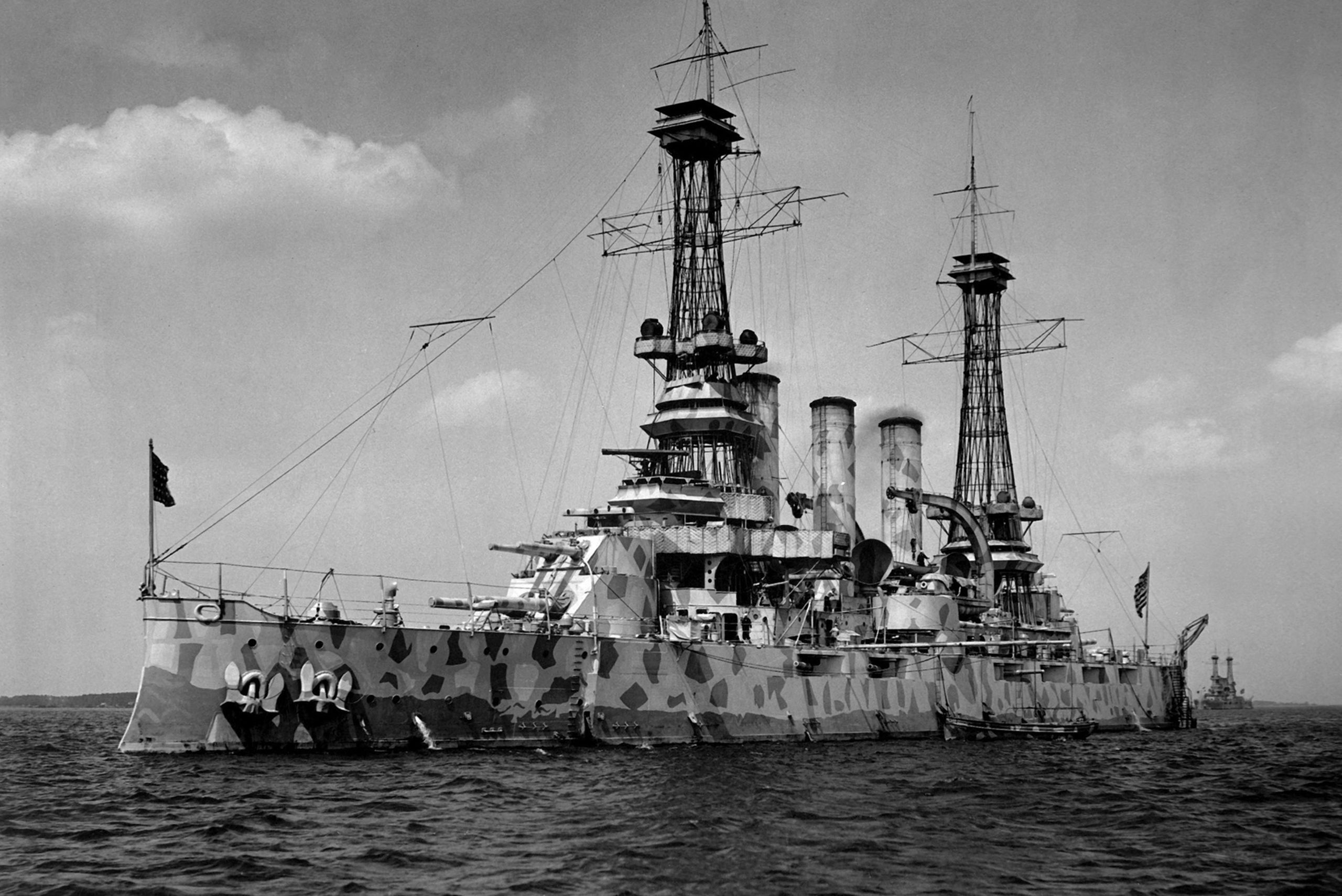
USS New Jersey in WW1 dazzle camouflage paint
February 1st land was sighted, and shortly after noon the NewJersey passed through Hampton Roads by the battleships which had just returned from service with the British fleet. Their bands turned out with "Hail, Hail, the Gang's All Here" and a rousing welcome was given. In the afternoon the New Jersey drew up to a pier at Newport News and the First Battalion was back on American soil after sixteen months' absence. The Red Cross was right on the job, distributing along with their welcoming smiles, chocolate, cookies and cigarettes, and they telegraphed to each emergency address the news of arrival. Led by a tinted stevedore band, the parade went through the city and out to Camp Stuart. Flags were flying; everyone was cheering; chocolate and fruit showered down. Incidentally, an onlooker was heard to remark, "Why, they haven't any guns!"
The next few days were spent in getting acclimated to real food, enjoying the luxuries of the Visitors' House, having battalion and company pictures taken, and riding in street cars again. It was discovered that Newport News had but little use for overseas men after the parade from the ship was over. A Major with three silver service stripes gave a couple of the fellows a very severe bawling out for not saluting him when he was encumbered with a lady and coming in from the side!
On February 7th occurred the dissolution of the Battalion. It was split into detachments
destined for camps near the enlistment places. Individually, though, some of the men did
not apply the red chevron until as late as February 27th--and then
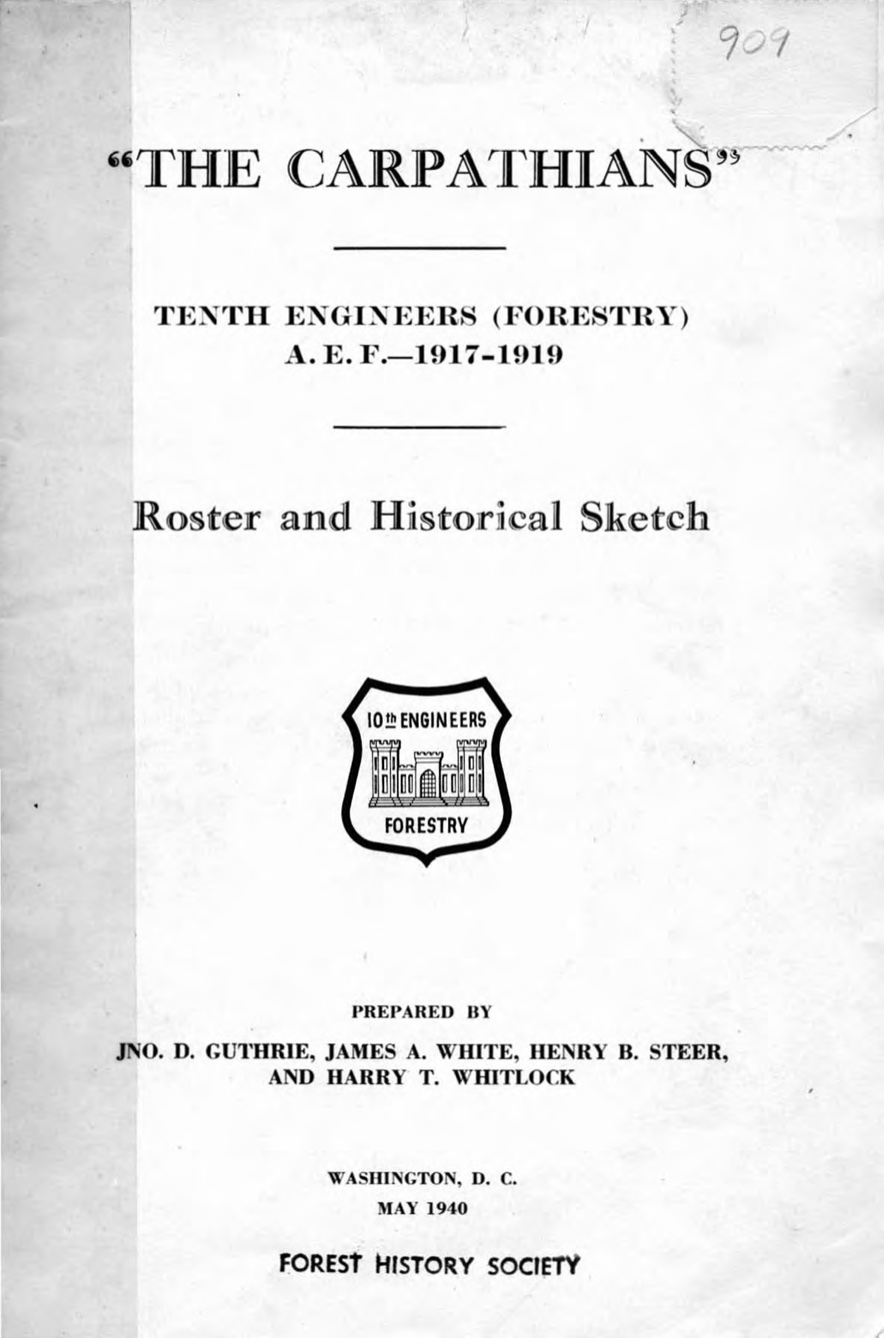
Click the image above for additional history about the 10th Engineers, as published in a pamphlet from its veterans, The Carpathians.
The pamphlet includes a full roster of all personnel assigned to the 10th Engineer Regiment (the 11th and 12th Battalions of the 20th Engineer Regiment).